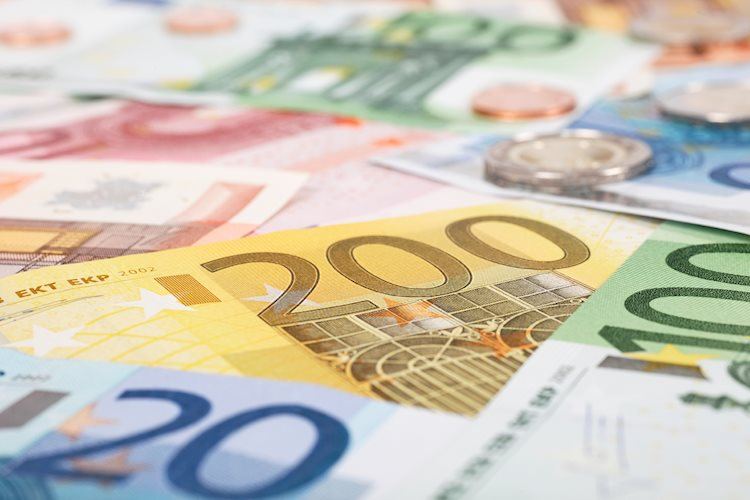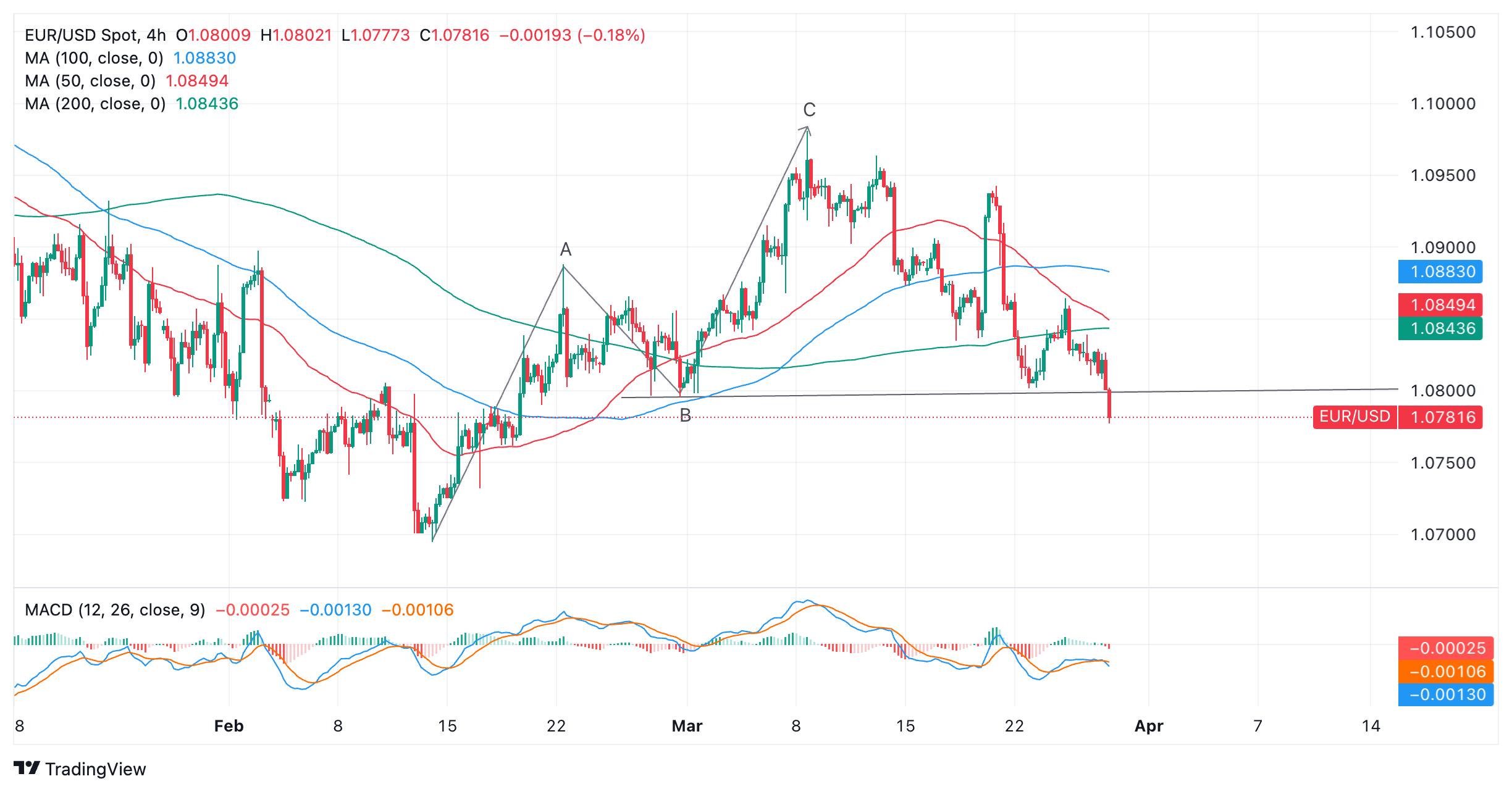EUR/USD fell on disappointing German retail sales.

- EUR/USD fell a further step on weak German retail sales data.
- A slowdown in consumer spending levels in Germany raises the possibility that the ECB will soon cut interest rates.
- This contrasts with the United States, where Federal Reserve officials advocate delaying interest rate cuts.
EUR/USD sold off on Thursday, breaking key support at 1.0800 after German retail sales data further heightened concerns about the health of Europe’s largest economy, weighing on the euro (EUR). The pair is also under downward pressure as the Federal Reserve is increasingly expected to delay interest rate cuts due to stronger economic data and rising inflation.
EUR/USD continues to decline, concerns over delay in Fed interest rate cut
The decline in EUR/USD extends a short-term downtrend that began after the rollover from the March 8 high in the 1.0980s. The main catalyst appears to be divergent opinions among interest rate makers at the US Federal Reserve (Fed) and the European Central Bank (ECB).
In early March, the ECB signaled it would cut interest rates by June and the Federal Reserve could do so as early as May, but recent stronger-than-expected U.S. data and sticky inflation have led many Fed officials to question whether rates could be cut too far. I brought it up. Interest rate cuts start early.
The view that the Federal Reserve could keep interest rates higher for longer supported the US dollar (USD). This is because higher interest rates tend to attract more foreign capital inflows. This is weak for EUR/USD, which measures the purchasing power of a single euro in USD terms.
On Wednesday, Federal Reserve Governor Christopher Waller added his voice to those advocating a delay, saying in a speech to the Economic Club of New York that “we are in no rush to cut policy rates,” according to Reuters.
ECB officials, on the other hand, were increasingly focused on June. Eurozone economic data is overall disappointing compared to US data. However, persistently high wage inflation still concerns some policymakers.
EUR/USD fell another notch on Thursday after German retail sales in February showed shoppers tightening their wallets. Weakening consumer spending is another sign that inflation will fall further, prompting the ECB to cut interest rates.
German retail sales fell 2.7% year-on-year, well below expectations of a 0.8% decline, according to data from Statistics Germany (Statistisches Bundesamt Deutschland). The 1.9% monthly decline must have come as a shock after economists had predicted a 0.3% rise.
Friday’s core US personal consumption expenditures (PCE) price index data for February, the Fed’s preferred indicator of inflation, is likely to be an even more important release for EUR/USD.
A higher-than-expected result could have negative consequences for both countries, pushing back even further when the Fed is expected to cut interest rates.
Technical Analysis: EUR/USD continues to trend lower.
EUR/USD extends the dominant short-term downtrend that started from the highs of March 8th. It has now fallen below key support at around 1.0800.

Euro vs US Dollar: 4-Hour Chart
The pair formed a three-wave price pattern called the Measured Move in February and early March, with the low of wave B supporting key support just above 1.0800.
If the ongoing break proves decisive, it would signal a continuation of the downtrend towards the next target of 1.0750, followed by the February low around 1.0700.
A decisive breakout is characterized by a long red bearish candle that completely breaks the level and closes near the low, or three consecutive bearish candles that break the level.
Alternatively, a move above the 1.0950 level could question the validity of the near-term downtrend.
Euro FAQs
The euro is the currency of the 20 European Union countries in the eurozone. It is the second most traded currency in the world after the US dollar. In 2022, it accounted for 31% of all foreign exchange transactions, with an average daily trading volume of over $2.2 trillion. EUR/USD is the most traded currency pair in the world, accounting for approximately 30% of all transactions, followed by EUR/JPY (4%), EUR/GBP (3%), and EUR/AUD (2%).
The European Central Bank (ECB), located in Frankfurt, Germany, is the reserve bank of the euro zone. The ECB sets interest rates and manages monetary policy. The ECB’s main task is to maintain price stability, which means controlling inflation or promoting growth. Its main tool is to raise or lower interest rates. Relatively high interest rates, or the expectation of higher interest rates, generally benefit the euro and vice versa. The ECB Board of Governors makes monetary policy decisions at meetings eight times a year. Decisions are made by a six-member executive board, including the heads of euro zone national banks and ECB President Christine Lagarde.
Eurozone inflation data, measured by the Harmonized Index of Consumer Prices (HICP), is an important econometric data source for the euro. If inflation rises more than expected, especially if it exceeds the ECB’s 2% target, the ECB will have to raise interest rates to control it. Relatively higher interest rates compared to other countries will generally benefit the euro. The euro makes the region more attractive as a place for global investors to store their funds.
The release of the data could gauge the health of the economy and have implications for the euro. Indicators such as GDP, manufacturing and services PMI, employment and consumer sentiment surveys can all influence the direction of the single currency. A strong economy is good for the euro. Not only would this attract more foreign investment, it could also encourage the ECB to raise interest rates, which could directly strengthen the euro. Otherwise, if economic indicators are weak, the euro is likely to fall. Economic data from the four largest euro area economies (Germany, France, Italy and Spain), which account for 75% of the eurozone economy, are particularly important.
Another important data release for the euro is the trade balance. This indicator measures the difference between the amount a country earned from exports and the amount it spent on imports during a specific period. If a country produces an export good that is in high demand, the value of that country’s currency will rise simply due to the additional demand created from foreign buyers willing to buy that good. Therefore, a positive net trade balance strengthens the currency, while a negative net trade balance strengthens the currency.
Source: https://www.fxstreet.com/news/eur-usd-pushes-lower-after-disappointing-german-retail-sale-202403280833



